![]()
![]()
![]()
Use LEFT and RIGHT arrow keys to navigate between flashcards;
Use UP and DOWN arrow keys to flip the card;
H to show hint;
A reads text to speech;
47 Cards in this Set
- Front
- Back
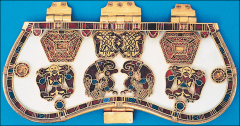
|
Title: Purse cover
Creator: N/A Location: from the Sutton Hoo burial in Suffolk, England Medium: Gold, glass and enamel cloisonne with garnets and emeralds Art Historical Era: Early Medieval 7 1/2 “ long The background is a modern background. Truncated pyramids of geometric interlace (patterns). Large-beaked birds attacking ducks Interlacing animal figures Cloisonne= small metal strips. Pyramids of geometric patterns, Heraldic motif – seen before in Sumarian art. |
|

|
Title: Man (symbol of Saint Matthew),
Creator: N/A Location: folio 21 verso of the Book of Durrow, possibly from Iona, Scotland Medium: Ink and tempera on parchment Art Historical Era: Early Medieval Oldest existent complete illuminated Gospel from Ireland or Britain 248 folios (done in vellum) Symbol of man later had wings |
|
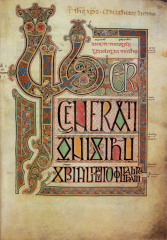
|
Title: Major decorated initial page at the beginning of the Gospel according to Saint Matthew
Creator: N/A Location: folio 27 verso of the Lindisfarne Gospels, from Northumbria, England Medium: Tempera on vellum Art Historical Era: Early Medieval Technique of tiny red drops (enhances the outline of the works; added decoration) Non-perfection seen in the letters “ER” that aren’t painted showing humility and not perfection. |
|
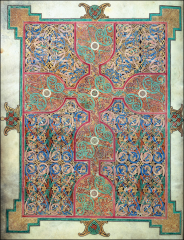
|
Title: Cross and carpet page
Creator: N/A Location: folio 26 verso of the Lindisfarne Gospels, from Northumbria, England Medium: Tempera on vellum Art Historical Era: Early Medieval 258 leaves Made to honor St. Cuthbert Latin copied by Eadfrith Anglo Saxon text added by Aldred The entire page is covered with zeomorphic interlace. The corners are done in simple w/o interlace. The alternating colors used throughout is an important characteristic. |
|
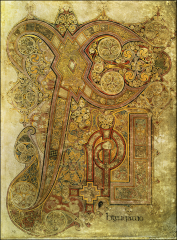
|
Title: Chi-rho-iota page
Creator: N/A Location: folio 34 recto of the Book of Kells, probably from Iona, Scotland Medium: Tempera on vellum Art Historical Era: Early Medieval late eighth or early ninth century. Opens account of the Nativity told at Christmas mass. Carpet page. This shows the 2nd beginning. Scene of the beginning of verse 18. Resembles metalwork of today. This reads: “Now this is how the birth of Christ came about” |
|
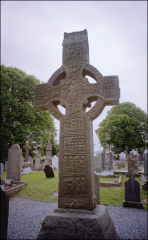
|
Title: High Cross of Muiredach (east face),
Creator: N/A Location: Monasterboice, Ireland Medium: Art Historical Era: Early Medieval Celtic cross with spoke-wheel design Last judgment, Christ holds a cross and flowering staff. Crucifixion Spirals, interlace and bosses, gadroon Cap stone with saints Reflect the influence of metalwork and motif. The cross is outlined with straddling. Shape of a church is at the top of the cross. Crucifixion is represented in the west face. Judgment day is represented in the east face. The blessed & the dammed fill the arms of the cross. |
|
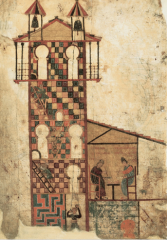
Emetrius, san salvador de tabara Colophon of commentary on apocolypse by beatus from tabara spain Islamic elements |
? |
|
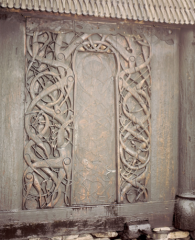
Wooden portal of the stave church Urnes norway Animal interlace |
? |
|
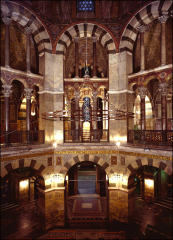
|
Title: Interior of the Palatine Chapel of Charlemagne
Creator: N/A Location: Aachen, Germany, Medium: Art Historical Era: Early Medieval Carolingian Influenced by Roman art seen in Ravenna |
|
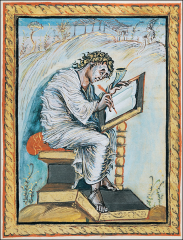
|
Title: Saint Matthew
Creator: Location: folio 18 verso of the Ebbo Gospels Medium: Art Historical Era: Early Medieval Carolingian style Linear, lots of curves, curvilinear, energized, rapid brushwork. This looks very energetic with the curving lines that follow the figure. Classical influence. The tone is different. The perspective is off here. An angel up there is the symbol of the evangelist. Classical merging with linear style of the North. Overlay of gold in the background (Byzantine art) |
|
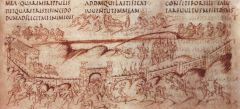
|
Title: Psalms 44
Creator: N/A Location: detail of folio 25 recto, Hautsvillers, France Medium: Ink on vellum Art Historical Era: Early Medieval Psalter=collection of the Psalms of King David Classical style with linear vitality of the Ebbo Gospels. Eutric Psalter. Done for the art bishop in Switzerland. 166 pen drawing. This illustrates what the psalms are saying. This is Psalms 44. The Israelites are compared to sheep, who are falling down in front of the wall of the city. Christ is up there with 3 angels on each side. |
|
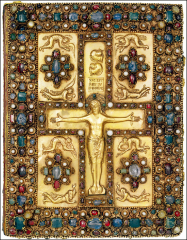
|
Title: Crucifixion
Creator: N/A Location: front cover of Lindau Gospels Medium: Cabochons Art Historical Era: Early Medieval Elements of Classical and Byzantine styles. Extremely lavish & splendid. The gems are rounded and set up so that light will catch them. The central figure is done with beaten metal. Foliage on the outside border. Mourners bellow the figure of Christ & angels above. The sun & moon above Christ’s head. |
|

|
Title: Doors with relief panels
Creator: N/A Location: Saint Michaels, Hildesheim, Germany Medium: Bronze Art Historical Era: Early Medieval Commissioned by Bishop Bernward Genesis, left door Life of Christ, right door “In the year of our Lord 1015 Bishop Berward installed the doors” Arduous life on left and the gifts of the Magi on right are around the door knobs, we see the 2 “Eves, Eve and Mary The lion door poles are interesting. The artist most likely had never seen a lion in Germany, so this was his imagination. Detail of the doors: The background is low relief with the trees and lots of empty spaces. The figures come out. Casting these figures seems difficult to do to a 16 ft door. The top part of the figure comes out, thus, we get more emotion. Left side: Offerings of Cain and Abel. Abel murdered by Cain. Right side: Nativity. Annunciation. The artist makes great use of empty space to add drama so that you can focus on what the figures are doing. |
|
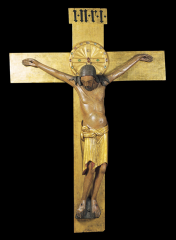
|
Title: Crucifix
Creator: N/A Location: commissioned by Archbishop Gero for the Cologne Cathedral, Germany Medium: painted wood Art Historical Era: Early Medieval Reliquary in head Shows horror of crucifixion Medium: can also be polychrome wood This is larger than life size. This Christ is older & bearded (vs. the other Christ was younger and looking at you) This one is more interested in the suffering and humanity of Christ (the other emphasized divinity) The whole thing is intensified with emotion. The muscles are pulling, shows tension in the arms. Restored in 1976. |
|
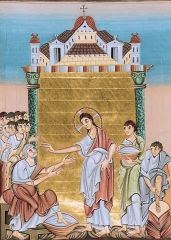
|
Title: Christ washing the feet of the disciples
Creator: Location: Aachen Gospels Medium: Ink, gold and colors on vellum Art Historical Era: Early Medieval Ottonian A lot of gold is used (Byzantine influence) City of Jerusalem at the top. The style looks fun. It’s a linear piece. Heavy lines, not much shading used. Peter is sitting. The figures are alike. The perspective is off. A lot of gesturing going on. |
|

|
Title: Cathedral of St. James
Creator: N/A Location: Santiago de Compostela, Galicia. Spain Medium: Art Historical Era: Romanesque Pilgrimage church Compostela= a field of stars. Barrel vault or tunnel vault (goes back like a tunnel) Compound pier in the nave that hold up the vaults. They’re not rounded. Extra support in the piers. Latin cross plan. Cruciform plan. Pilgrimage churches feature: An aisle al the way around the transept adds more space. The ambulatory adds more space and directs traffic. Chapels on the transept is another feature. Apse with radiating chapels around it. The nave is divided into sections. These section are ways vaiys. There’s no clerestory (section of windows). The lantern tower illuminates the pulpit. |
|
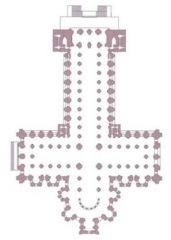
|
Title: Cathedral of St. James
|
|

|
Title: Aerial view of Saint-Sernin
Creator: N/A Location: Toulouse, France Medium: Art Historical Era: Romanesque Cruciform plan with transept Two side aisles. Apse with radiating chapels and transept with chapels. Buttressing on the outside (looks like flattened square pillars that support the walls on the exterior) Crossing tower (where nave an transept meet) Ambulatory is typical to romanesque church. |
|
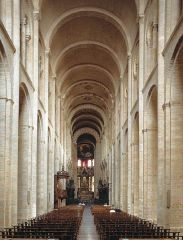
|
Title: Saint-Sernin
Creator: N/A Location: , Toulouse, France Medium: Art Historical Era: Romanesque Small windows bc of the buttress system. Bright colors used on inside, use of gold in the reliquies. Candle lights as the main source of illumination. |
|
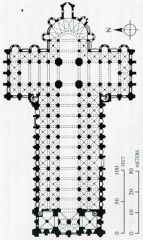
|
Title: Saint-Sernin
The lines that are straight across: indicates the barrel vaults. They’re flattened. Groin vaults are also seen. 2 story elevation. Nave, transept, ambulatory, apse, radiating chapels. |
|
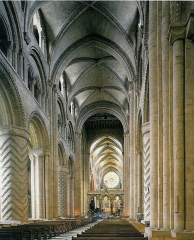
|
Title: Durham Cathedral
Creator: N/A Location: England Medium: Art Historical Era: Romanesque Ribbed groin vault. The nave arcade, gallery section, and clerestory section up there. Part of the rose windows are gothic. Apse, transept, galleries. This has a buttressing system bc it looks high. The arches on the outside are buttressing the vaults on the inside to get the extra height. It helps support so it wont fall down. Massive columns, massive pier, giant heavy columns, thus, alternation in the nave. The columns have ornaments on them (chevron, diamond,) This was brightly painted when it was originally bulit. Divide into the Bay system of the Romanesque period. |
|
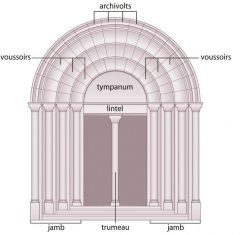
|
KNOW the name of these portals!
The portals of churches become a major focus of decoration during the Romanesque period, especially in the tympanum. Portal= is a transport into another room. The arch signifies triumph. Archivolts= moldings around the tympanum. Made of the voussoirs (wedged shaped pieces that fit together) |
|
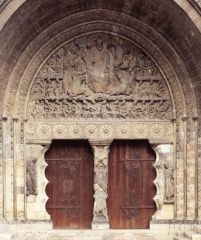
|
Title: South portal of Saint-Pierre
Creator: N/A Location: Saint-Pierre, Moissac, France Medium: Art Historical Era: Romanesque Christ in Majesty with angels Apocalyptic vision. The scene is taken out of the book of Revelation. Christ in majesty with his angels. 4 symbols of the evangelists and flanked by 2 angels. The scallop jamb: the carving is pointed (influence from Islamic) |
|
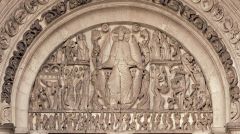
|
Title: Last Judgment
Creator: Gislebertus Location: West Tympanum of St. Lazare at Autun, France Medium: Art Historical Era: Romanesque On the left: the ppl are going to heaven. An angel lifting ppl up to heaven. The ppl are pilgrims bc they are carrying bags, one has a cross (been to Jerusalem). On the right side, hands are coming down and plucking the damned up. |
|
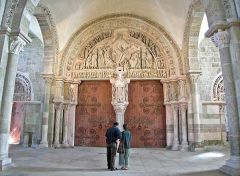
|
Title: Ascension of Christ and Mission of the Apostles
Creator: Location: tympanum of the center portal of the narthex of La Madeleine, Vezelay, France Medium: Art Historical Era: Romanesque Located in the Narthex. It’s the second set of doors. Associated with the Crusades. |
|

|
Title: Virgin and Child (Morgan Madonna)
Creator: Location: Auvergne, France Medium: second half of 12th century painted wood Art Historical Era: Romanesque Mary is considered the Throne of Wisdom since she gave human form to God as Jesus Christ. This is a free standing sculpture. Painted wood: walnut The lion throne is from king Salomon (represented earthly wisdom) Devotional statue: it was at an altar, pray to it, light candles. |
|

|
Title: Bayeaux Embroidery [Bayeaux Tapestry] (after 1066)
Creator: N/A Location: England Medium: Art Historical Era: Romanesque Bishop Odo Blessing the Feast and a detail Looks like they’re roasting something. |
|
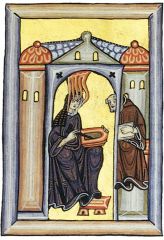
|
Title: The vision of Hildegard of Bingen
Creator: N/A Location: detail in the Scivias by Hildegard of Bingen, from Trier or Bingen, Germany Medium: Art Historical Era: Romanesque Hildegard was the most prominent nun of the 12th century. She wrote important treatises on medicine and science and was also an important composer. She had mystical visions since the age of 5, and one of them is depicted here as 5 tongues of fire enter her brain. She’s shown as an artist portrait. The flames of light coming down from God. This is not original. This is from black & white photographs. |
|
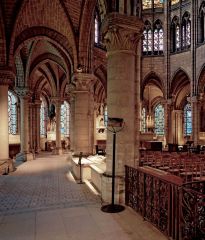
|
Title: Ambulatory and radiating chapels
Creator: N/A Location: Abbey church, Saint-Denis, France Medium: Art Historical Era: Gothic The apse plan: the ambulatory is opened up. The walls are no longer there. The rib vaults are somewhat pointed which makes it possible to go higher with the vaults. Instead of having the heavy walls, there are buttress on the outside because they want the interior of the cathedral to be different from Romanesque. |
|
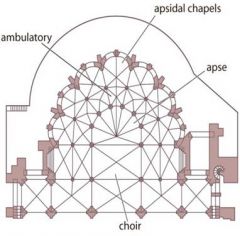
|
Apse and Choir of Abbey Church of Saint-Denis
|
|
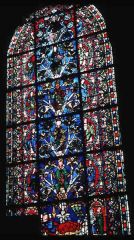
|
Title: Tree of Jesse
Creator: N/A Location: Saint-Denis, Paris, France Medium: Stained glass in chancel and rose windows Art Historical Era: Gothic |
|
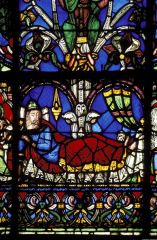
|
Title: Tree of Jesse
Creator: N/A Location: Saint-Denis, Paris, France Medium: Stained glass in chancel and rose windows Art Historical Era: Gothic Shows the genealogy of Jesus. The black color in the stained glass is where the lead is holding it together. |
|
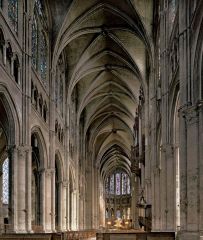
|
Title: Nave
Creator: N/A Location: Cathedral of Notre-Dame in Chartres, France Medium: Art Historical Era: Gothic Example of high Gothic. Clerestory windows, nave arcade. 4 part ribbed vault. The choir is right behind the altar and in front of the ambulatory. The passageway goes around the choir. Wide nave, 2 side aisles, the ambulatory section has another aisle in in it. Romanesque apse (means there are 3 radiating chapels) |
|
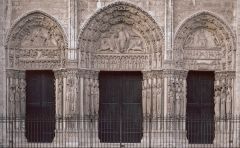
|
Title: Royal Portal
Creator: N/A Location: , west façade, Chartres Cathedral, Chartres, France Medium: Art Historical Era: Gothic ca. 1145-1155 The oldest example of early Gothic that survived. Themes carried over from the Romanesque: The 12 disciples, 12 zodiacs, 12 labors of the monks, 24 elders Mary seated in the throne of wisdom, Jesus going up into heaven. Jamb figures, their style is ordered, the figures are still, they’re not as active as the Romanesque figures. |
|
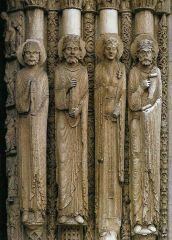
|
Title: Old Testament kings and queen, jamb statues
Creator: N/A Location: central doorway of Royal Portal, Chartres Cathedral, Chartres, France Medium: Art Historical Era: Gothic ca. 1145-1155 This marks the beginning of monumental sculpture. The sculpture is still attached to the columns. The figures are elongates (as they were in Romanesque). They’re in deep relief. They don’t carry the weight of the column. They’re peaceful, frontal, less contorted (not moving) than their predecessors, and less linear (less defined by lines) |
|
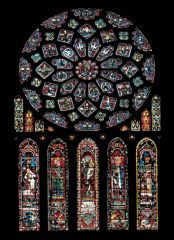
|
Title: Rose window and lancets
Creator: N/A Location: north transept, Chartres Cathedral, Chartres, France Medium: Stained glass, rose window approx. 43’ in diameter Art Historical Era: Gothic ca. 1220 Mary is seen as the queen of heaven. She’s surrounded by the doves. 4 doves=4 gospels. In the center: Anne (the virgins mother) with Mary seated on her lap. 2 kings: David & Salomon. 2 Prophets. |
|

|
Title: Saint Theodore, jamb statue
Creator: Location: Porch of the Martyrs (left doorway) south transept, Chartres Cathedral, Chartres, France Medium: Art Historical Era: Gothic ca. 1230 An evolution in the style is seen. Canopies over the heads. The figures are standing in a pedestal. From the left: St. Theodore: an important figure bc he shows naturalism—he’s standing on his own, stands in a slight controposto form, he’s relaxed. He’s dressed as a Christian warrior. The faces are individualized. These are ppl that suffered for the Christian faith. |
|

|
Title: West façade
Creator: John D (architect) Location: of Reims Cathedral, Reims, France Medium: Art Historical Era: Gothic High Gothic. The arches are more pointed. The portal extended forward. Gable up above. Emphasis on the outside of verticality and lavish decoration. Associated with the French kings, thus, it had to become elaborately decorated. |
|

|
Title: Cathedral of Notre-Dame
Creator: N/A Location: Reims (1211-1311), France Medium: Art Historical Era: Gothic 125 ft. Plate tracery= where the sections were cut out the stones. |
|
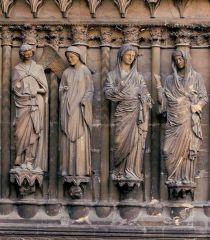
|
Title: Visitation
Creator: N/A Location: jamb statues of central doorway, Reims Cathedral Medium: Art Historical Era: Gothic Ara Pacis, South Procession, Roman the statues are more 3D and more naturalistic. slight controposto stance. Similarity to Classical statues (similar drapery) serene expression. Mary visits her cousin Elizabeth and they rejoice for their pregnancies. The knees are seen. They're contained in their space. They're turning slightly to each other to converse. |
|
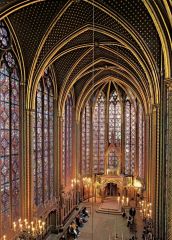
|
Title: Interior of the upper chapel
Creator: N/A Location: Sainte-Chapelle, Paris, France Medium: Art Historical Era: Gothic Commissioned by King Louis IX (also known as Saint Louis) to house his collection of relics, most importantly Christ’s crown of thorns. Two story building—upper story with walls of stained glass. |
|

|
Title: Interior of Salisbury
Creator: N/A Location: Cathedral (view facing east), Salisbury, England Medium: Art Historical Era: Gothic 1220-1258 The piers don’t come all the way up to the triforium into the clerestory. They stop in the nave arcade. Keeps the triforium separate. The triforium is large. The clerestory is small. Lower vault seen. The columns are rounded with the colenets attached to them (typical of early English style) English style seen: The vaults are 6-part vault (not 4 part) When the ribs meet they have a decorative. |
|
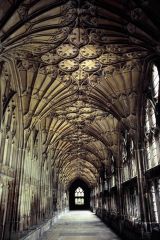
|
Title: Gloucester Cathedral, cloisters
Creator: N/A Location: England Medium: Art Historical Era: Gothic Fan vaulting Early Perpendicular style 1332-1357 On the right pic: high columns seen and round Roman arches (Roman romanesque characteristics) 6 part vault at the top. Left pic: early Perpendicular style. Unified interior, verticality, looks very unified, not broken down. The ribs are going up in equal space form each other making the fan vaulting. The Perpendicular style is only in England. Fan vaulting originated in Gloucester Cathedral. Very distinctive & easy to recognize. |
|
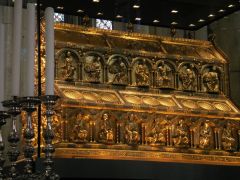
|
Title: Shrine of the Three Kings
Creator: Nicholas of Verdun Location: Cathedral Treasury, Cologne Cathedral Medium: Silver and bronze with enamel and gemstones Art Historical Era: Gothic 5’8” x 6’ x 3’8” 1190-1210 This has the bones & clothing of the Magi. Open in 1864. Originally this was in Constantinople. This attracted pilgrims from all over to this shrine. This gave the right to bishops to crown the German kings. The apostles on the top, prophets along the side. In the front, the Virgin Mary with the Magi. In the back, scenes of the crucifixion. This is the largest reliquary in the world. |
|

|
Title: David before Saul
Creator: Jean Pucelle Location: folio 24 verso of the Belleville Breviary, Paris, France Medium: Ink and tempera on vellum Art Historical Era: Gothic 9 ½” x 6 ¾” ca. 1325 Contains 2 volumes of prayer (1 for the summer & 1 for the winter). David before Saul seen at the top left. An Italian influence seen. Saul seated on his throne, he’s monumental in size. Shading is seen. He looks bulky. On the bottom: a more quartley style. Cain is killing Abel. The priest are giving the Eucharist the dove (Holy Spirit). The figure of charity depicted by the woman. Retains an interest in decoration and geometric patterns. |
|

|
Title: Virgin and Child (Virgin of Paris)
Creator: N/A Location: Notre-Dame, Paris, France Medium: Art Historical Era: Gothic Art S-curve, not supporting the figure Unearthly grace early 14th century Fully in the round. She’s very elegant. Example of quart style (Louis the 9th). Shown young, fashionable, wealthy. She stands more mannered in style. She’s swaying, not controposto. |
|
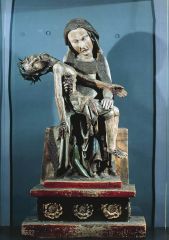
|
Title: Virgin with the Dead Christ (Rottgen Pieta)
Creator: N/A Location: Rhineland, Germany Medium: Painted wood Art Historical Era: Gothic Art 2’ 10 ½” high Pieta (latin) means pitty & piety. Images of contemplation. This is meant to be at an altar. Grieving mother Mary. Horrified of the dead Christ. They’re trying to evoque and emotion from the viewer. It’s so dramatic. |

